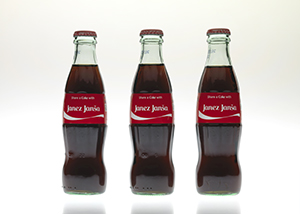350 Janez Janša Bottles
Would Coca Cola taste as sweet with another name? One of the bigger efforts in post-Fordist economies has been to give customers the feeling that we are no longer addressed as an anonymous mass, but as individuals. The informatization of production and distribution systems has greatly helped this process. One of the key words today in marketing and manufacturing is “mass customization” – the use of flexible computer-aided manufacturing systems to produce custom output. One of its variants – the most skin deep, and the most effective – is called “cosmetic customization”, where a standard product is presented differently to different customers, allowing personalization in the way the product is packaged, such as giving the product your name.
Cosmetic customization appeals to Janez Janša, Janez Janša and Janez Janša, who have used it in different recent works based on personalized credit cards, Nutella jars and Coca Cola bottles, and it fits into their investigation of identity in contemporary society and their reactivation of the idea of readymade.
350 Janez Janša Bottles is a pop readymade that playfully adopts and subverts cosmetic customization, produced by exploiting the personalization procedure offered by the Coca Cola Company to replace the name of the product with the name Janez Janša. The process is subverted because Janez Janša is – as a name – both personal and shared by at least four public persons (the three artists and the Slovene political figure), and because it has been printed on 350 bottles – a small supply that doesn’t conform to the idea of personalization implicit in mass customization. As a readymade, its peculiarity lies in the fact that it’s not a mass produced item turned into an artwork by an individual act of signing, repurposing or displacement, but the output of a process which is totally embedded in the current means of production and distribution. Like any customer, the artists “produced” it by simply filling in a form and accepting pre-determined terms and conditions.
But, like most works by Janez Janša, Janez Janša and Janez Janša, this playful intervention also raises uncomfortable questions: what distinguishes an artwork from an everyday object? Are these bottles a conceptual statement, shameless self-celebration or, even worse, an act of political propaganda? Is a name change nothing more than a cosmetic gesture? Would Coca Cola taste different with the name Janez Janša?
Domenico Quaranta



